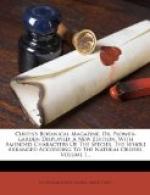[114]
SILENE PENDULA. PENDULOUS CATCHFLY.
Class and Order.
DECANDRIA TRIGYNIA.
Generic Character.
Calyx ventricosus. Petala 5, unguiculata coronata
ad faucem, Capsula
3-locularis.
Specific Character and Synonyms.
SILENE pendula calycibus fructiferis pendulis
inflatis: angulis decem
scabris. Linn.
Syst. Vegetab. ed. 14. Murr. p. 421.
VISCAGO hirsuta sicula, lychnidis aquaticae facie,
supina. Dill. Hort.
Elth. 421. t.
312. f. 404.
[Illustration: No 114]
Grows spontaneously in Sicily and Crete; is an annual of humble growth, and hence a suitable plant for the borders of the flower garden, or the decoration of Rock-work, as its blossoms are shewy, and not of very short duration.
It flowers in June and July, and if once permitted to scatter its seeds, will come up yearly without any trouble.
[115]
LATHYRUS SATIVUS. BLUE-FLOWER’D LATHYRUS,
or
CHICHLING-VETCH.
Class and Order.
DIADELPHIA DECANDRIA.
Generic Character.
Stylus planus, supra villosus, superne latior.
Calycis laciniae
superiores 2 breviores.
Specific Character and Synonyms.
LATHYRUS sativus pedunculis unifloris, cirrhis
diphyllis
tetraphyllisque,
leguminibus ovatis compressis dorso bimarginatis.
Linn.
Syst. Vegetab. ed. 14. Murr. p. 662.
LATHYRUS sativus, flore fructusque albo. Bauh. Pin. 343.
[Illustration: No 115]
A native of France, Spain, and Italy, and distinguishable when in flower by the blue colour of its blossoms, which are sometimes, however, milk-white; but its seed-pods afford a more certain mark of distinction, being unusually short, broad, and winged on the back.
This species grows to the height of about two feet, and is usually sown in the spring with other annuals; though not so beautiful, it forms a contrast to the sweet and Tangier Pea, and may be introduced where there is plenty of room, or a desire of possessing and knowing most of the plants of a genus.
It flowers in June and July.
Cultivated 1739, by Mr. PHILIP MILLER. Ait. Hort. Kew.
[116]
LIMODORUM TUBEROSUM. TUBEROUS-ROOTED LIMODORUM.
Class and Order.
GYNANDRIA DIANDRIA.
Generic Character.
Nectarium monophyllum, concavum, pedicellatum, intra petalum infimum.
Specific Character and Synonyms.
LIMODORUM tuberosum floribus subspicatis barbatis.
Ait. Hort. Kew. p.
301.
[Illustration: No 116]
For this rare plant I am indebted to the very laudable exertions of a late Gardener of mine, JAMES SMITH, who, in the spring of the year 1788, examining attentively the bog earth which had been brought over with some plants of the Dionaea Muscipula, found several small tooth-like knobby roots, which being placed in pots of the same earth, and plunged into a tan-pit having a gentle heat, produced plants the ensuing summer, two of which flowered, and from the strongest of those our figure was taken.




